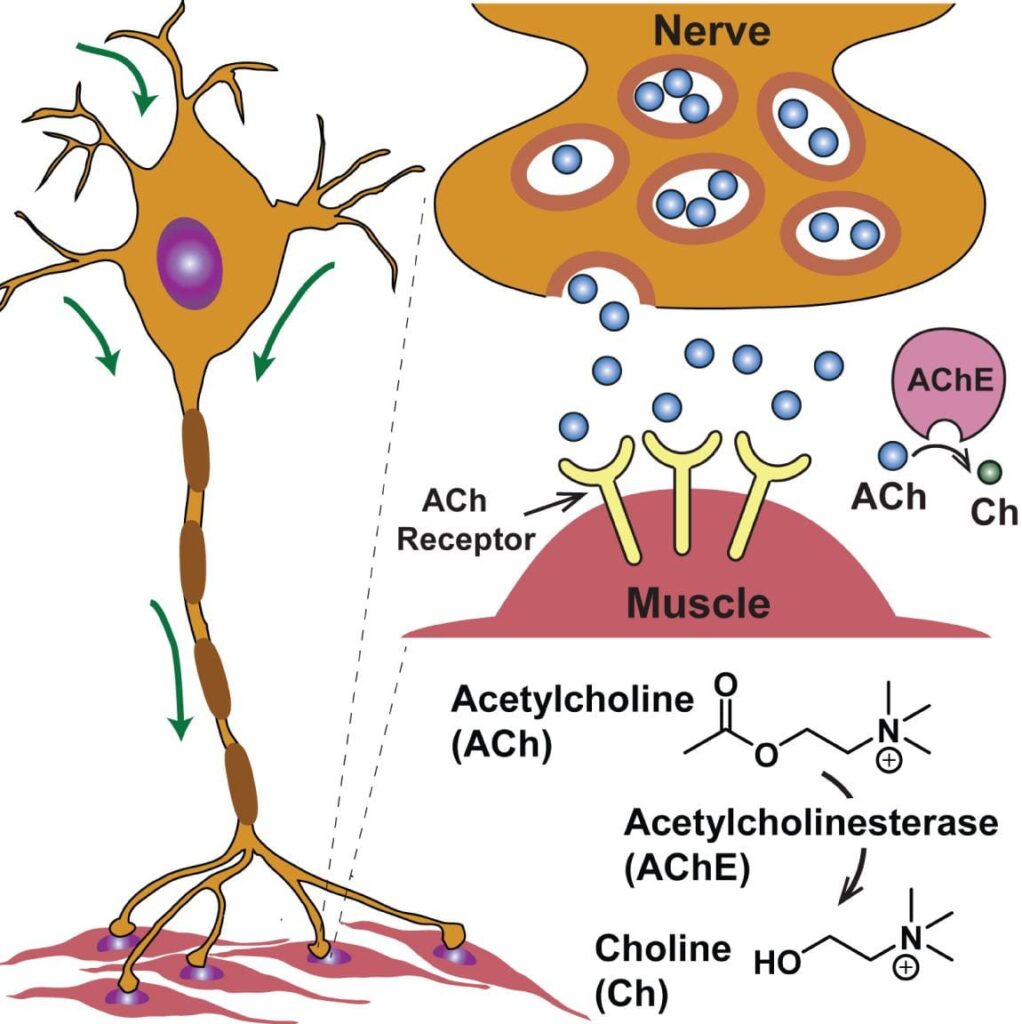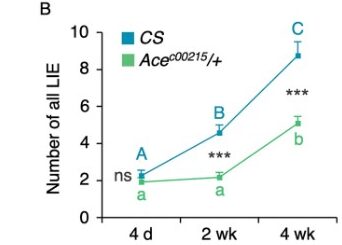Introduction
Neurotransmission and regulation of neurotransmitter release are key components in regulating behavior. Of the neurotransmitters, acetylcholine, also a neuromodulator, plays a crucial role in attention, behavioral control, and muscle contraction. Chemically, acetylcholine requires choline and acetyl-CoA for synthesis, and is released by cholinergic neurons throughout the brain and at neuromuscular junctions. Acetylcholine binds to the muscarinic or nicotinic cholinergic receptor, each receptor family containing multiple subtypes, all with varying functionality. Adequate acetylcholine regulation is critical for attention, as shown in rats that displayed significant impairments in attention when treated with a nicotinic acetylcholine receptor (nAChR) antagonist. Beyond attention, acetylcholine is critical for proper inhibitory control, an executive function that allows for inhibition of habitual behaviors. However, the data pooled from rodent and human studies regarding acetylcholine and inhibitory control have been quite contradicting. This current review from a paper published in Scientific reports on December 3rd, 2022, titled Acetylcholine deficit causes dysfunctional inhibitory control in an aging-dependent manner, offers a model for analyzing acetylcholine’s action on inhibitory control in drosophila.

Takeaways: Acetylcholine, a neuromodulator, is assembled from choline and acetyl-CoA. Acetylcholine is released by cholinergic neurons, found throughout the brain, and plays a vital role in inhibitory control, attention, and muscular contraction. Due to contradicting results when comparing rodent and human models of acetylcholine’s impact on inhibitory control, this journal review explores a fly model.
Results
Inhibitory control is essential for executing goal-directed behavior. Improper regulation of inhibitory control leads to impulsive actions and thoughts, thus deterring the subject from goals that are not yet habitual. To assess the change in inhibitory control over-time, the researchers used a go/no-go test (GNG). The GNG test measures constraint against a no-go signal. Under no wind conditions, flies are free to move about the cage. However, introduction of a strong wind results in a decrease in movement, most likely to increase survival percentage during a strong wind event. To test whether age increased the number of inhibition events, the authors counted how many times the fly disobeyed this inhibitory behavior, thus notating this action “loss of inhibition events” (LIE) at different time points. To implicate the impact of acetylcholine, the researchers compared wild-type (CS) to Ace-c00215 flies. The Ace-c00215 allele is a null variant encoding acetylcholinesterase, therefore there is significantly less acetylcholinesterase in these flies compared to wild-type flies. The less acetylcholinesterase is present, the more acetylcholine is active in the synaptic cleft.
The first figure [1B] relays information about the total number of LIE in 4d, 2wk, and 4wk old flies that have a wild-type or the Ace/+ genotype. Two primary results can be concluded from this figure. First, regardless of acetylcholinesterase level, the number of LIE increases in an age-dependent fashion. Second, the increase of acetylcholinesterase (Ace) significantly reduces the number of LIE compared to wild-type (CS) flies. This result suggests a large role for acetylcholine in inhibitory control.

The second figure [1C] compares the latency to the initial LIE in wild-type (CS) and Ace flies over-time. An increase in latency to the initial LIE shows positive inhibitory control. The wild-type flies show a significant decrease in latency time to initial LIE when compared to Ace flies, further implementing acetylcholine’s role in inhibitory control. The decrease in acetylcholinesterase prevents the decrease in latency time to initial LIE in flies up to 4 weeks.

The authors measured acetylcholine (ACh) levels as seen in figure [1D]. In both wild-type (CS) and Ace flies, acetylcholine levels decline over-time, suggesting an age-dependent decrease in acetylcholine. Also, the Ace flies show significantly more acetylcholine at each time point compared to wild-type mice. Together, these results show acetylcholine declines in an age-dependent manner, as well as implements acetylcholine as a key player in inhibitory control.

Takeways: The loss of inhibition events (LIE) refers to an event in which a fly moves during an inappropriate time. The total number of loss of inhibition events increases in an age-dependent manner and is significantly reduced in flies with increased acetylcholine. The results implement acetylcholine as a regulator of inhibitory control, and acetylcholine decreases over-time, indicating an increase in loss inhibition events as flies age.
To further support the notion that acetylcholine is vital for inhibitory control, the researchers genetically removed the choline acetyltransferase (ChAT) enzyme. ChAT is the enzyme responsible for the biosynthesis of acetylcholine from choline. The ChAT enzyme is encoded by one gene in both humans and drosophila, making this a practical model. Using an immunoreactivity test, the researchers verified the ChAT M104508 and ChAT M108244 heterozygous variants had significantly less acetylcholine compared to wild-type flies (CS) [Figure 2B, C].
After verifying successful ChAT suppression, the researchers used the same experiment as previously described to determine the number of LIE. Briefly, flies were exposed to strong wind conditions, and movement was deemed a LIE. The results [Figure 2G] compared the total number of LIE over-time in 1) ChAT M104508 2) ChAT M108244 or 3) wild-type (3) flies. At 4 days, there are no significant differences between treatment groups. However, in an age-dependent manner, the total number of LIE increases in either of the ChAT groups. The results from this experiment suggest a crucial role for acetylcholine in inhibitory control, such that acetylcholine-deficit impairs inhibitory control.

To verify the role of acetylcholine in inhibitory control, the researchers compared a variety of genetically differing flies. The genetic make-up of the groups are: 1) Ace-c00215/+ 2)ChAT-MI04508/+ 3) ChAT-MI4508/+ / Ace-c00215 and 4) wild-type (CS). The Ace groups contain a mutation that blunts acetylcholinesterase, thus increasing acetylcholine. Whereas, the ChAT groups harbor a mutation resulting in a decrease in choline acetyltransferase, thus decreasing acetylcholine. As seen in figure [3A], the total number of LIE significantly increases over-time in all groups, this verifying an age-dependant function in inhibitory control. Also, the addition of the Ace mutation alleviates the impact of the ChAT mutation on the number of LIE.

The researcher quantified the amount of acetylcholine in each treatment group. As expected, the ChAT mutation resulted in a significant decline in acetylcholine levels compared to all other groups. Also, the ChAT/Ace group showed wild-type levels of acetylcholine, thus supporting the conclusion from [3A]. Of note, the group harboring the Ace mutation had significantly increased acetylcholine level at any age point.

Discussion
Acetylcholine dysregulation has been connected with several diseases, including Alzheimer’s disease. It modulates a large population of neurons and has critical roles in attention. Currently, its role regarding inhibitory control, an executive function allowing for inhibition of a habitual action, has been under-fire due to contradicting results in human and rodent models. The aim of this paper was to identify the role of acetylcholine in inhibitory control using genetically modified drosophila or fruit flies. Flies harboring a mutation resulting in decreasing acetylcholinesterase showed significantly better inhibitory control compared to wile-type flies. To further support the role of acetylcholine in inhibitory control, flies containing a null choline acetyltransferase allele showed significantly worse inhibitory control compared to wild-type flies. To verify the findings, the authors showed that flies harboring both mutations (increased acetylcholinesterase/ decreased choline acetyltransferase) had restored inhibitory control and increased acetylcholine levels compared with choline acetyltransferase mutated flies. The researchers also identified that this inhibitory control decreases with age along with levels of acetylcholine.
Acetylcholine deficit results in significantly impaired inhibitory control
Practical Takeaways
Inhibitory control refers to the ability to not perform a behavior that is deemed natural or habitual to complete a goal. This is also referred to as impulse control. Key ideas around success stem from delaying instant gratification. For example, hunger on a diet is near impossible to curve without abusing stimulants or pharmaceuticals. The ability to sustain a caloric-deficit and overcome the hunger is a positive action for the long-term goal of losing weight but goes against fundamental survival behaviors. Other examples, like watching television or over-consuming social media when other goals, whether financial, physical, or mental, are present, represent a lack of impulse control. The flooding of dopamine from social media is rewarding, while studying may instantly feel rewarding (without bio hacking). This paper alludes to the fundamental role of acetylcholine in inhibitory control, suggesting that increasing acetylcholine may lessen the number of impulsive actions. There also seems to be an age-dependent decrease in acetylcholine, hence, a decrease in the ability to control impulses. Possible remedies to control impulses may revolve around administration of alpha-GPC, which have showed to increase acetylcholine contents in the brain. These results suggest that dose-adjustments are needed in an age-dependent manner, with older individuals needing a higher dose.

Meet the Author
Hello everyone,
My name is Joshua Giblin. I am a post-bachelor researcher/research technician at USC. My interests range from nutrition to nanomedicine and also practical science to improve everyday life. Through this blog, I aim to communicate practical scientific research and present it to curious individuals so that an educated decision can be made. Thank you for reading the blog and showing your support.
Literature cited
- Sabandal, P. R., Saldes, E. B., & Han, K.-A. (2022). Acetylcholine deficit causes dysfunctional inhibitory control in an aging-dependent manner. Scientific Reports, 12(1), Article 1. https://doi.org/10.1038/s41598-022-25402-z